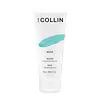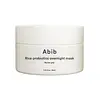What's inside
What's inside
 Key Ingredients
Key Ingredients

 Benefits
Benefits

 Concerns
Concerns

No concerns
 Ingredients Side-by-side
Ingredients Side-by-side

Water
Skin ConditioningButyrospermum Parkii Butter
Skin ConditioningC15-19 Alkane
SolventGlycerin
HumectantC10-18 Triglycerides
EmollientNiacinamide
SmoothingCaprylic/Capric Triglyceride
MaskingC12-16 Alcohols
EmollientPropanediol
SolventCetyl Alcohol
EmollientHydrogenated Lecithin
EmulsifyingPalmitic Acid
EmollientPanthenol
Skin ConditioningMauritia Flexuosa Fruit Oil
Skin ConditioningYeast Extract
Skin ConditioningCaprylhydroxamic Acid
Soy Amino Acids
Skin ConditioningMyrciaria Dubia Fruit Extract
Skin ConditioningAsparagopsis Armata Extract
Skin ProtectingAscophyllum Nodosum Extract
Skin ConditioningRosmarinus Officinalis Leaf Extract
AntimicrobialSodium Hyaluronate
HumectantGlucomannan
Skin ConditioningTocopherol
AntioxidantEthylhexyl Palmitate
Emollient1,2-Hexanediol
Skin ConditioningStearyl Alcohol
EmollientTitanium Dioxide
Cosmetic ColorantCarbomer
Emulsion StabilisingXanthan Gum
EmulsifyingParfum
MaskingSorbitol
HumectantButylene Glycol
HumectantTriethanolamine
BufferingSclerotium Gum
Emulsion StabilisingLecithin
EmollientPullulan
Trihydroxystearin
Skin ConditioningCI 15985
Cosmetic ColorantSilica
AbrasiveWater, Butyrospermum Parkii Butter, C15-19 Alkane, Glycerin, C10-18 Triglycerides, Niacinamide, Caprylic/Capric Triglyceride, C12-16 Alcohols, Propanediol, Cetyl Alcohol, Hydrogenated Lecithin, Palmitic Acid, Panthenol, Mauritia Flexuosa Fruit Oil, Yeast Extract, Caprylhydroxamic Acid, Soy Amino Acids, Myrciaria Dubia Fruit Extract, Asparagopsis Armata Extract, Ascophyllum Nodosum Extract, Rosmarinus Officinalis Leaf Extract, Sodium Hyaluronate, Glucomannan, Tocopherol, Ethylhexyl Palmitate, 1,2-Hexanediol, Stearyl Alcohol, Titanium Dioxide, Carbomer, Xanthan Gum, Parfum, Sorbitol, Butylene Glycol, Triethanolamine, Sclerotium Gum, Lecithin, Pullulan, Trihydroxystearin, CI 15985, Silica
Water
Skin ConditioningDipropylene Glycol
HumectantGlycerin
HumectantGlyceryl Polymethacrylate
Lactobacillus/Rice Ferment
Skin Conditioning1,2-Hexanediol
Skin ConditioningDiglycerin
HumectantAmmonium Acryloyldimethyltaurate/Vp Copolymer
Oryza Sativa Bran Extract
Skin ConditioningAcrylates/C10-30 Alkyl Acrylate Crosspolymer
Emulsion StabilisingTromethamine
BufferingSaccharomyces/Rice Bran Ferment
HumectantEthylhexylglycerin
Skin ConditioningAdenosine
Skin ConditioningSodium Hyaluronate
HumectantAllantoin
Skin ConditioningDisodium EDTA
Water, Dipropylene Glycol, Glycerin, Glyceryl Polymethacrylate, Lactobacillus/Rice Ferment, 1,2-Hexanediol, Diglycerin, Ammonium Acryloyldimethyltaurate/Vp Copolymer, Oryza Sativa Bran Extract, Acrylates/C10-30 Alkyl Acrylate Crosspolymer, Tromethamine, Saccharomyces/Rice Bran Ferment, Ethylhexylglycerin, Adenosine, Sodium Hyaluronate, Allantoin, Disodium EDTA
 Reviews
Reviews

Ingredients Explained
These ingredients are found in both products.
Ingredients higher up in an ingredient list are typically present in a larger amount.
1,2-Hexanediol is a synthetic liquid and another multi-functional powerhouse.
It is a:
- Humectant, drawing moisture into the skin
- Emollient, helping to soften skin
- Solvent, dispersing and stabilizing formulas
- Preservative booster, enhancing the antimicrobial activity of other preservatives
Glycerin is already naturally found in your skin. It helps moisturize and protect your skin.
A study from 2016 found glycerin to be more effective as a humectant than AHAs and hyaluronic acid.
As a humectant, it helps the skin stay hydrated by pulling moisture to your skin. The low molecular weight of glycerin allows it to pull moisture into the deeper layers of your skin.
Hydrated skin improves your skin barrier; Your skin barrier helps protect against irritants and bacteria.
Glycerin has also been found to have antimicrobial and antiviral properties. Due to these properties, glycerin is often used in wound and burn treatments.
In cosmetics, glycerin is usually derived from plants such as soybean or palm. However, it can also be sourced from animals, such as tallow or animal fat.
This ingredient is organic, colorless, odorless, and non-toxic.
Glycerin is the name for this ingredient in American English. British English uses Glycerol/Glycerine.
Learn more about GlycerinSodium Hyaluronate is hyaluronic acid's salt form. It is commonly derived from the sodium salt of hyaluronic acid.
Like hyaluronic acid, it is great at holding water and acts as a humectant. This makes it a great skin hydrating ingredient.
Sodium Hyaluronate is naturally occurring in our bodies and is mostly found in eye fluid and joints.
These are some other common types of Hyaluronic Acid:
Learn more about Sodium HyaluronateWater. It's the most common cosmetic ingredient of all. You'll usually see it at the top of ingredient lists, meaning that it makes up the largest part of the product.
So why is it so popular? Water most often acts as a solvent - this means that it helps dissolve other ingredients into the formulation.
You'll also recognize water as that liquid we all need to stay alive. If you see this, drink a glass of water. Stay hydrated!
Learn more about Water